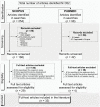Advances in Concentration Gradient Generation Approaches in a Microfluidic Device for Toxicity Analysis
- PMID: 36231063
- PMCID: PMC9563958
- DOI: 10.3390/cells11193101
Advances in Concentration Gradient Generation Approaches in a Microfluidic Device for Toxicity Analysis
Abstract
This systematic review aimed to analyze the development and functionality of microfluidic concentration gradient generators (CGGs) for toxicological evaluation of different biological organisms. We searched articles using the keywords: concentration gradient generator, toxicity, and microfluidic device. Only 33 of the 352 articles found were included and examined regarding the fabrication of the microdevices, the characteristics of the CGG, the biological model, and the desired results. The main fabrication method was soft lithography, using polydimethylsiloxane (PDMS) material (91%) and SU-8 as the mold (58.3%). New technologies were applied to minimize shear and bubble problems, reduce costs, and accelerate prototyping. The Christmas tree CGG design and its variations were the most reported in the studies, as well as the convective method of generation (61%). Biological models included bacteria and nematodes for antibiotic screening, microalgae for pollutant toxicity, tumor and normal cells for, primarily, chemotherapy screening, and Zebrafish embryos for drug and metal developmental toxicity. The toxic effects of each concentration generated were evaluated mostly with imaging and microscopy techniques. This study showed an advantage of CGGs over other techniques and their applicability for several biological models. Even with soft lithography, PDMS, and Christmas tree being more popular in their respective categories, current studies aim to apply new technologies and intricate architectures to improve testing effectiveness and reduce common microfluidics problems, allowing for high applicability of toxicity tests in different medical and environmental models.
Keywords: CGG; concentration gradient generator; drug screening; microdevice; microdevice gradient generator; microfluidic device; toxicity.
Conflict of interest statement
The authors declare no conflict of interest.
Figures



References
-
- Chapman K.L., Holzgrefe H., Black L.E., Brown M., Chellman G., Copeman C., Couch J., Creton S., Gehen S., Hoberman A., et al. Pharmaceutical toxicology: Designing studies to reduce animal use, while maximizing human translation. Regul. Toxicol. Pharmacol. 2013;66:88–103. doi: 10.1016/j.yrtph.2013.03.001. - DOI - PubMed
-
- Singh S., Khanna V.K., Pant A.B. Chapter 1—Development of In Vitro Toxicology: A Historic Story. In: Dhawan A., Kwon S., editors. In Vitro Toxicology. Academic Press; Cambridge, MA, USA: 2018. pp. 1–19.
-
- Saxena S., Joshi R. Microfluidic Devices: Applications and Role of Surface Wettability in Its Fabrication. IntechOpen; London, UK: 2020.
Publication types
MeSH terms
Substances
LinkOut - more resources
Full Text Sources

